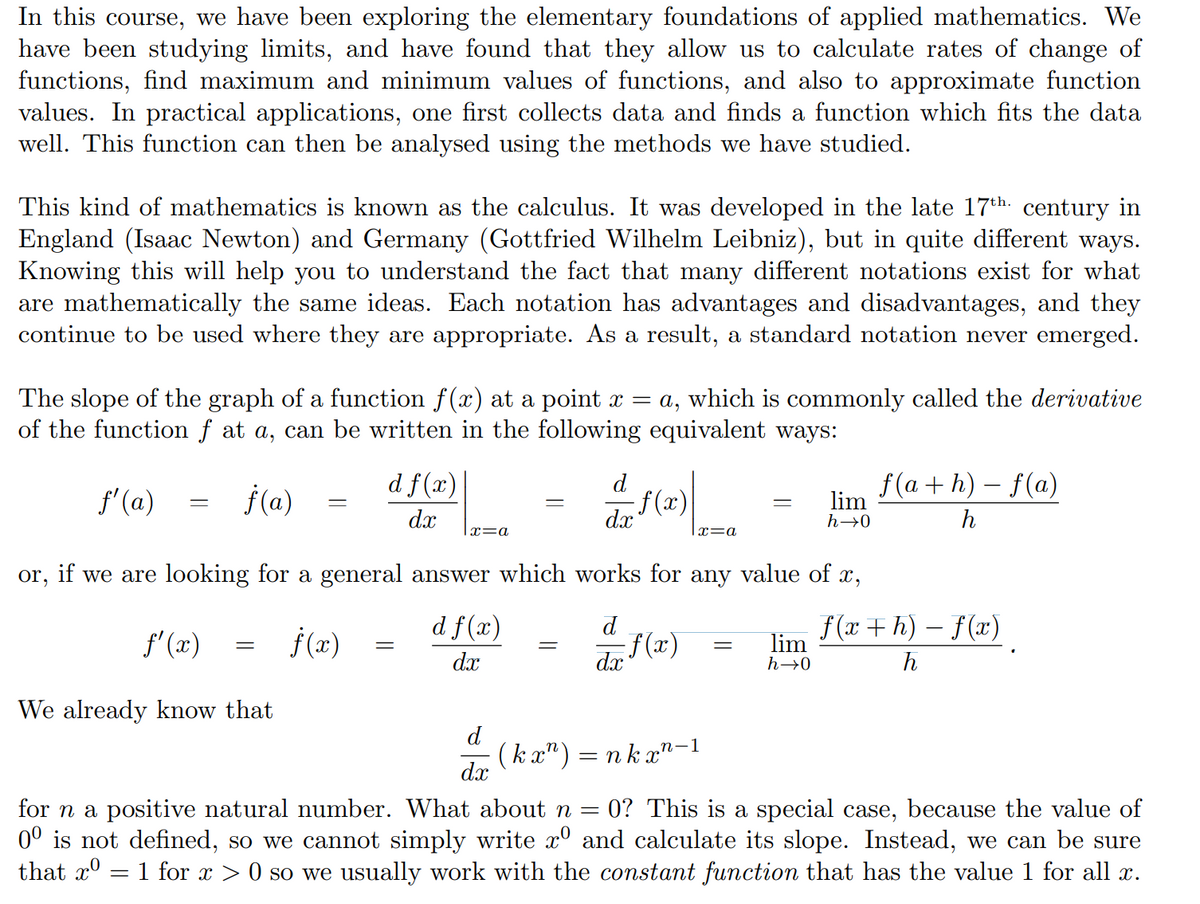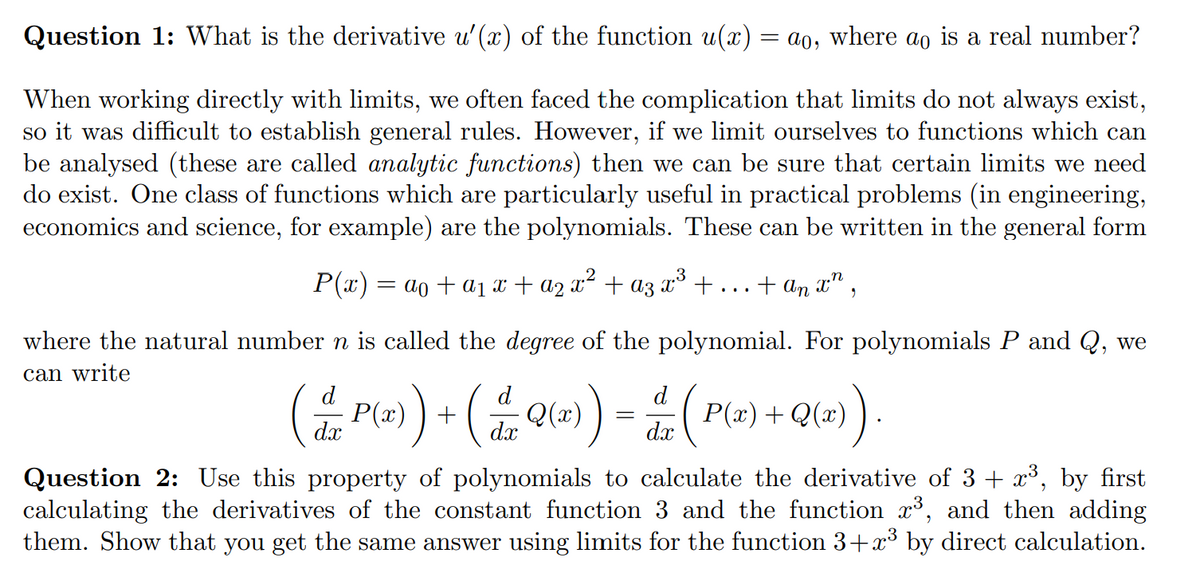Question 2: Use this property of polynomials to calculate the derivative of 3 + x³, by first calculating the derivatives of the constant function 3 and the function x³, and then adding them. Show that you get the same answer using limits for the function 3+x³ by direct calculation.
Question 2: Use this property of polynomials to calculate the derivative of 3 + x³, by first calculating the derivatives of the constant function 3 and the function x³, and then adding them. Show that you get the same answer using limits for the function 3+x³ by direct calculation.
College Algebra
7th Edition
ISBN:9781305115545
Author:James Stewart, Lothar Redlin, Saleem Watson
Publisher:James Stewart, Lothar Redlin, Saleem Watson
Chapter2: Functions
Section: Chapter Questions
Problem 30P: In this problem you are asked to find a function that models in real life situation and then use the...
Related questions
Question
100%
What's the answer to the 2nd question?
Please see the attached screenshots for the quesiton.

Transcribed Image Text:In this course, we have been exploring the elementary foundations of applied mathematics. We
have been studying limits, and have found that they allow us to calculate rates of change of
functions, find maximum and minimum values of functions, and also to approximate function
values. In practical applications, one first collects data and finds a function which fits the data
well. This function can then be analysed using the methods we have studied.
This kind of mathematics is known as the calculus. It was developed in the late 17th. century in
England (Isaac Newton) and Germany (Gottfried Wilhelm Leibniz), but in quite different ways.
Knowing this will help you to understand the fact that many different notations exist for what
are mathematically the same ideas. Each notation has advantages and disadvantages, and they
continue to be used where they are appropriate. As a result, a standard notation never emerged.
The slope of the graph of a function f(x) at a point x = a, which is commonly called the derivative
of the function f at a, can be written in the following equivalent ways:
f'(a)
j(a)
d f(x)|
f(x)
dx
d
f(a + h) – f(a)
lim
dx
h→0
h
|x=a
x=a
or, if we are looking for a general answer which works for any value of x,
f' (x)
f (x)
d f(x)
d
(x)
f(x +h) – f(x)
lim
dx
dx
h→0
h
We already know that
d
(k x") = nk x"-1
dx
for n a positive natural number. What about n =
0° is not defined, so we cannot simply write x° and calculate its slope. Instead, we can be sure
that xº = 1 for x > 0 so we usually work with the constant function that has the value 1 for all x.
0? This is a special case, because the value of

Transcribed Image Text:Question 1: What is the derivative u'(x) of the function u(x) = ao, where ao is a real number?
When working directly with limits, we often faced the complication that limits do not always exist,
so it was difficult to establish general rules. However, if we limit ourselves to functions which can
be analysed (these are called analytic functions) then we can be sure that certain limits we need
do exist. One class of functions which are particularly useful in practical problems (in engineering,
economics and science, for example) are the polynomials. These can be written in the general form
P(x) = ao + a1 x + a2 x² + az x³ +
+ an x" ,
where the natural number n is called the degree of the polynomial. For polynomials P and Q, we
can write
)=
d
d
d
P(x)
dx
P(x)+Q(x)
dx
dx
Question 2: Use this property of polynomials to calculate the derivative of 3 + x³, by first
calculating the derivatives of the constant function 3 and the function x³, and then adding
them. Show that you get the same answer using limits for the function 3+x³ by direct calculation.
Expert Solution
Step 1

Step by step
Solved in 2 steps with 2 images

Knowledge Booster
Learn more about
Need a deep-dive on the concept behind this application? Look no further. Learn more about this topic, calculus and related others by exploring similar questions and additional content below.Recommended textbooks for you

College Algebra
Algebra
ISBN:
9781305115545
Author:
James Stewart, Lothar Redlin, Saleem Watson
Publisher:
Cengage Learning

College Algebra (MindTap Course List)
Algebra
ISBN:
9781305652231
Author:
R. David Gustafson, Jeff Hughes
Publisher:
Cengage Learning

Elementary Linear Algebra (MindTap Course List)
Algebra
ISBN:
9781305658004
Author:
Ron Larson
Publisher:
Cengage Learning

College Algebra
Algebra
ISBN:
9781305115545
Author:
James Stewart, Lothar Redlin, Saleem Watson
Publisher:
Cengage Learning

College Algebra (MindTap Course List)
Algebra
ISBN:
9781305652231
Author:
R. David Gustafson, Jeff Hughes
Publisher:
Cengage Learning

Elementary Linear Algebra (MindTap Course List)
Algebra
ISBN:
9781305658004
Author:
Ron Larson
Publisher:
Cengage Learning